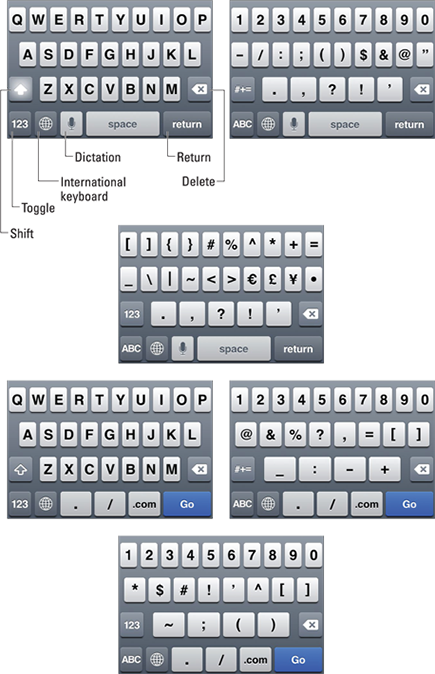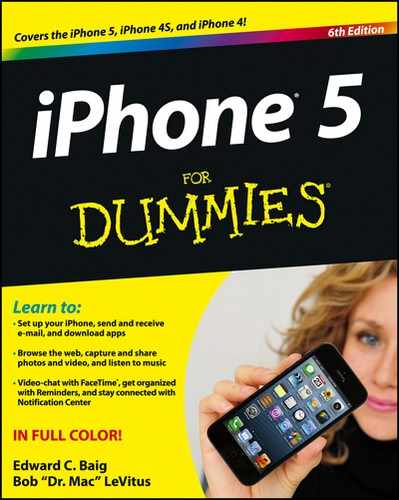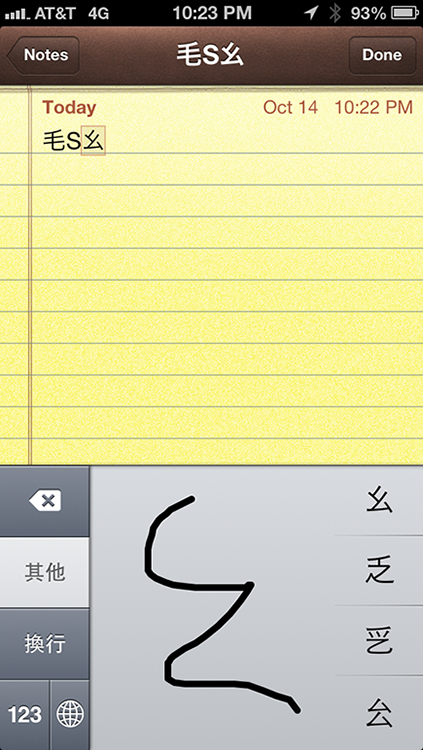Figure 2-3: The ABCs of virtual typing.
Mastering the Multitouch Interface
Until the iPhone came along, virtually every cell phone had a physical (typically plastic) dialing keypad, if not also a more complete QWERTY-style keyboard, to bang out e-mails and text messages. The iPhone dispenses with both. Apple is once again living up to an old company advertising slogan to “Think Different.”
Indeed, the iPhone removes the usual physical buttons in favor of a multitouch display. This display is the heart of many things you do on the iPhone, and the controls change depending on the task at hand.
Unlike other phones with touchscreens, don’t bother looking for a stylus. You are meant, instead — at the risk of lifting another ancient ad slogan — to “let your fingers do the walking.”
It’s important to note that you have at your disposal several keyboard layouts in English, all variations on the alphabetical keyboard, the numeric and punctuation keyboard, and the more punctuation and symbols keyboard. Six keyboards are shown in Figure 2-1. The layout you see depends on the app you are working in. For instance, the keyboards in Safari differ from the keyboards in Notes.

Figure 2-1: Six faces of the iPhone keyboard.

Figure 2-2: Going wide on the keyboard.
Discovering the special-use keys
The iPhone keyboard contains five keys that don’t actually type a character (refer to Figure 2-1). These special-use keys follow:
![]() Shift key: Switches between uppercase and lowercase letters if you’re using the alphabetical keyboard. If you’re using keyboards that show only numbers and symbols, the traditional shift key is replaced by a key labeled #+= or 123. Pressing that key toggles between keyboards that have just symbols and numbers.
Shift key: Switches between uppercase and lowercase letters if you’re using the alphabetical keyboard. If you’re using keyboards that show only numbers and symbols, the traditional shift key is replaced by a key labeled #+= or 123. Pressing that key toggles between keyboards that have just symbols and numbers.
 To turn on caps lock mode and type in all caps, you first need to enable caps lock. You do that by tapping the Settings icon, then tapping General, and then tapping Keyboard. Tap the Enable Caps Lock item to turn it on. After the caps lock setting is enabled (it’s disabled by default), you double-tap the shift key to turn on caps lock. (The shift key turns blue when caps lock is on.) Tap the shift key again to turn off caps lock. To disable caps lock completely, just reverse the process by turning off the Enable Caps Lock setting (tap Settings, General, Keyboard).
To turn on caps lock mode and type in all caps, you first need to enable caps lock. You do that by tapping the Settings icon, then tapping General, and then tapping Keyboard. Tap the Enable Caps Lock item to turn it on. After the caps lock setting is enabled (it’s disabled by default), you double-tap the shift key to turn on caps lock. (The shift key turns blue when caps lock is on.) Tap the shift key again to turn off caps lock. To disable caps lock completely, just reverse the process by turning off the Enable Caps Lock setting (tap Settings, General, Keyboard).
![]() Toggle key: Switches between the different keyboard layouts.
Toggle key: Switches between the different keyboard layouts.
![]() International keyboard key: Shows up only if you’ve turned on an international keyboard, as explained in the sidebar titled “A keyboard for all borders,” later in this chapter.
International keyboard key: Shows up only if you’ve turned on an international keyboard, as explained in the sidebar titled “A keyboard for all borders,” later in this chapter.
![]() Delete key: Erases the character immediately to the left of the cursor.
Delete key: Erases the character immediately to the left of the cursor.
 If you hold down the delete key for a few seconds, it begins erasing entire words rather than individual characters.
If you hold down the delete key for a few seconds, it begins erasing entire words rather than individual characters.
![]() Return key: Moves the cursor to the beginning of the next line.
Return key: Moves the cursor to the beginning of the next line.
![]() Microphone/Siri key (iPhone 4S and iPhone 5 only): Tapping this key, which appears in apps such as Notes and Messages, lets you use Siri to dictate your words. More on Siri in Chapter 7.
Microphone/Siri key (iPhone 4S and iPhone 5 only): Tapping this key, which appears in apps such as Notes and Messages, lets you use Siri to dictate your words. More on Siri in Chapter 7.
The incredible, intelligent, and virtual iPhone keyboard
Before you consider how to actually use the keyboard, we’d like to share a bit of the philosophy behind its so-called intelligence. Knowing what makes this keyboard smart will help you make it even smarter when you use it. The iPhone keyboard
![]() Uses a bundled English dictionary that even includes words from today’s popular culture.
Uses a bundled English dictionary that even includes words from today’s popular culture.
![]() Adds your contacts to its dictionary automatically.
Adds your contacts to its dictionary automatically.
![]() Uses complex analysis algorithms to predict the word you’re trying to type.
Uses complex analysis algorithms to predict the word you’re trying to type.
![]() Suggests corrections as you type, and then offers you the suggested word just below the word you typed. When you decline a suggestion and the word you typed is not in the iPhone dictionary, the iPhone adds that word to its dictionary and offers it as a suggestion if you mistype a similar word in the future.
Suggests corrections as you type, and then offers you the suggested word just below the word you typed. When you decline a suggestion and the word you typed is not in the iPhone dictionary, the iPhone adds that word to its dictionary and offers it as a suggestion if you mistype a similar word in the future.
 Remember to decline suggestions (by tapping the characters you typed as opposed to the suggested words that appear below what you’ve typed), because doing so helps your intelligent keyboard become even smarter.
Remember to decline suggestions (by tapping the characters you typed as opposed to the suggested words that appear below what you’ve typed), because doing so helps your intelligent keyboard become even smarter.
![]() Reduces the number of mistakes you make as you type by intelligently and dynamically resizing the touch zones for certain keys. You can’t see it, but the iPhone increases the zones for keys it predicts might come next and decreases the zones for keys that are unlikely to come next.
Reduces the number of mistakes you make as you type by intelligently and dynamically resizing the touch zones for certain keys. You can’t see it, but the iPhone increases the zones for keys it predicts might come next and decreases the zones for keys that are unlikely to come next.
Navigating beyond the Home screen
The Home screen, which we discuss in Chapter 1, isn’t the only screenful of icons on your phone. After you start adding apps from the iTunes App Store (see Chapter 15), you’ll likely have multiple screens.
Initially, you see three tiny dots above the Phone, Mail, Safari, and Music icons. Each dot denotes an additional screen, containing up to 16 additional icons (up to 20 on the iPhone 5) for apps or folders of apps. The leftmost dot, which is dimmed (and, on close inspection, is shaped like a tiny magnifying glass), denotes the Search screen, which you access by flicking from left to right across the middle of the screen or by tapping directly on the dot. The second dot, which is all white, represents the Home screen, or the screen you’re currently viewing. The next dot to the right is the first additional screen in which you can park icons. You get to it by flicking right to left (assuming you’re on the first screen) or tapping the dot. Including the Search screen, you can have 12 screens in all; as you add screens, you add dots.
The four icons in the bottom row — Phone, Mail, Safari, and Music — are in a part of the screen known as the dock. When you switch from screen to screen as just described, these icons remain on the screen.
You can easily move icons within a screen or from screen to screen. Simply press and hold any icon until all the icons on the screen begin to jiggle. Then drag the icon you want to park elsewhere to its new location. The other icons on the screen kindly step aside to make room. To move an icon to an entirely new screen, drag it to the right or left edge of the screen. When you’re satisfied with the new layout, press the Home button to stop the jiggling.
Want to jump back to the first screenful of icons or the Home screen? Simply press the Home button. Pressing a second time brings you to a handy Spotlight search feature, which we address at the end of this chapter, in the “Searching” section.
Press and hold the Home key for more than a second or so to summon Siri on the iPhone 4S and iPhone 5, or Voice Control on all older iPhones except the original model (unless you turn the feature off in Settings).
Finger-typing on the virtual keyboards
Apple’s multitouch interface just might be considered a stroke of genius. And it just might as equally drive you nuts, at least initially.
If you’re patient and trusting, you’ll get the hang of finger-typing in a week or so. You have to use the virtual keyboard that appears when you tap a text field to enter notes, compose text messages, type the names of new contacts, and so forth.
As we’ve noted, Apple has built a lot of intelligence into its virtual keyboard, so it can correct typing mistakes on the fly and take a stab at predicting what you’re about to type next. The keyboard isn’t exactly Nostradamus, but it does a pretty good job in coming up with the words you have in mind.
As you press your finger against a letter or number on the screen, the individual key you press gets bigger and practically jumps off the screen, as shown in Figure 2-3. That way, you know that you struck the correct letter or number.


Figure 2-4: Accenting your letters.
Meanwhile, if you press and hold the .com key on a Safari keyboard, it offers you the choice of .com, .net, .edu, .us, or .org. Pretty slick stuff.
Alas, typing mistakes are common at first. Say that you meant to type a sentence in the Notes app that reads, “I am typing a bunch of notes.” But because of the way your fingers struck the virtual keys, you actually entered “I am typing a bunch of npyrs.” Fortunately, Apple knows that the o you meant to press is next to the p that showed up on the keyboard, just as t and y and the e and the r are side-by-side. So the software determines that notes was indeed the word you had in mind and places it in red under the suspect word, as shown in Figure 2-5. To accept the suggested word, merely tap the space key. And if for some reason you actually did mean to type npyrs instead, tap the suggested word (notes in this example) to decline it.

Figure 2-5: When the keyboard bails you out.
If you’re using the Notes app (Chapter 5), the keyboard does have a space key. And if you’re composing an e-mail message, a dedicated @ key pops up on the keyboard.
See Chapter 19 for a slick trick (the slide) that avoids the extra step involved in moving between the 123 and ABC keys.
As mentioned, you can rotate the iPhone so that its keyboard changes to a wider landscape mode in certain apps, including Mail, Messages, and Notes. The feature was already present in Safari. The keys are slightly larger in landscape mode, a boon to those who do a lot of typing or have largish fingers.
Editing mistakes
It’s a good idea to type with abandon and not get hung up over mistyped characters. The self-correcting keyboard will fix many errors. That said, plenty of typos will likely turn up, especially in the beginning, and you’ll have to make corrections manually.

Figure 2-6: Magnifying errors.
Cutting, copying, pasting, and suggesting
Being able to copy and paste text (or images) from one place on a computer to another has seemingly been a divine right since Moses, but getting to this Promised Land on the iPhone took awhile. Apple eventually added Copy and Paste (and Cut) — and, in its own inimitable way, brought pizzazz to this long-requested feature. Apple also has provided another helpful remedy for correcting errors: a Suggest pop-up option that appears when you double-tap a word. (A Define option is here too.)
Here’s how to exploit the copy-and-paste feature. Say you’re in the Notes app, jotting down ideas that you want to copy into an e-mail message. Double-tap a word to select it, and then drag the blue grab points or handles to select a larger block of text, as shown in Figure 2-7. (You can use the handles to contract selected text too.) After you’ve selected the text, tap Copy. (If you want to delete the text block, tap Cut instead.

Figure 2-7: Drag the grab points to select text.
Now open the Mail program (Chapter 12) and start composing a message. When you decide where to insert the text you just copied, tap the cursor. Up pop commands to Select, Select All, and Paste, as shown in Figure 2-8. Tap Paste to paste the text into the message.

Figure 2-8: Tap Paste to make text appear from nowhere.
Here’s the pizzazz part. If you make a mistake while you’re cutting, pasting, suggesting, or typing, shake the iPhone. It undoes the last edit.
Or suppose that you notice a typo in what you’ve entered. In Figure 2-9, for example, we inadvertently typed their instead of there. By tapping Suggest, we can easily make a fix. Upon doing so, the iPhone serves up a few suggested replacement words. If the word you have in mind as a substitute is, um, there, tap it and the iPhone automatically makes the switch. Another example: Say you inadvertently typed Freek. When you tap Suggest, the iPhone presents alternatives such as Greek, Freak, and Freed.
Meanwhile, if you want to know exactly what a word means, you can double-tap a word and choose the Define option instead. The first time you tap Define, you’ll be presented with the option to download the dictionary.

Figure 2-9: Tap Suggest and then tap a substitute word to make a switch.



 If you press two times in rapid succession, you won’t jump to the first Home screen or Spotlight Search screen. Instead, the multitasking tray (described in the “Multitasking” section, later in this chapter) appears. So remember to pause briefly between presses if you want to jump to the Home or Spotlight Search screens, and press twice in rapid succession to invoke multitasking.
If you press two times in rapid succession, you won’t jump to the first Home screen or Spotlight Search screen. Instead, the multitasking tray (described in the “Multitasking” section, later in this chapter) appears. So remember to pause briefly between presses if you want to jump to the Home or Spotlight Search screens, and press twice in rapid succession to invoke multitasking.